Table of contents
Attrition rates are high, and engagement is low. Job seekers are prioritizing flexibility and job security after Covid-19 as companies are implementing engagement strategies to retain their workforce. In 2024, companies are facing increasing turnover as 59% of employees globally are “quiet quitting”, while 75% are considering leaving their jobs due to disengagement. The U.S. and Canada see engagement rates at around 31%, while countries like Australia and Singapore struggle with lower levels of retention and well-being challenges. Understanding the labor market and addressing these trends is crucial for improving retention globally.
Definition of retention rates
Retention rates are a critical metric that indicates the stability and satisfaction of employees within an organization over a specified period. It measures the percentage of employees who remain employed by the end of a given time frame, typically calculated annually. High retention rates often reflect a positive work environment and effective management practices, whereas low retention rates may signal underlying issues such as poor workplace culture, inadequate benefits, or lack of career growth opportunities.
Understanding retention rates enables companies to develop targeted strategies to retain top talents, thereby enhancing overall organizational performance.
Importance of retention rates
Employee retention rates are critically important for several reasons. From reducing costs associated with recruiting and training to serving as a barometer for employee satisfaction and organizational health, a high retention rate can become a sustainable competitive advantage for employers. Low retention rates, however, may reveal underlying issues within the organization such as poor leadership, insufficient benefits, or a lack of career advancement opportunities. By focusing on employee retention, such as building a culture of recognition to increase engagement, organizations maintain continuity and stability, which is essential for fostering innovation and long-term growth.
Current state of employee retention within major global organizations
Recent trends in retention rates
One noticeable shift across various industries is the increasing need for hybrid work and flexible scheduling. As big corporations like Google and Amazon are commencing their five-day return-to-office, a significant number of employees are considering leaving the companies. A Cisco study found that 82% of employees say working from home has made them happier, while 60% saw their productivity enhanced. Companies that provide flexible work options have experienced higher retention rates, as employees value greater work-life balance.
As 91% of companies globally invested more in employees’ mental health solutions this year, a focus on mental health and well-being initiatives at work is another major rising trend. Companies that prioritize employees’ well-being through comprehensive wellness programs and support services have seen an improvement in retention. Many are also focusing on diversity and inclusion in the workplace and making sure employees feel valued and respected. By staying attuned to these emerging trends, businesses can better align their retention strategies to meet the evolving needs and expectations of their employees.
Industry averages and benchmarks
Understanding industry averages and benchmarks for employee retention rates is crucial for organizations looking to gauge their performance relative to their peers. A 2024 survey of nearly 4,000 US and Canadian organizations shows that the average voluntary turnover rate in Canada is at 11.9%, with the highest rate of 25.9% for the Retail and Wholesale industry. These benchmarks vary significantly across different sectors, given the unique challenges and dynamics each industry faces. Voluntary turnover rates also vary by employee groups. For example, below are the numbers in Canada, according to a 2024 study by Mercer:
- Head of organizations and executives: 3.8%
- Management: 6.6%
- Sales professionals: 6.4%
- Non-sales professionals: 8.3%
- White collar professionals: 10.5%
- Blue collar professionals: 11.5%
Ultimately, aligning with industry benchmarks not only helps in retaining top talent but also enhances overall organizational performance in a highly competitive market.
Main factors affecting retention rates
Workplace culture and environment
Company culture impacts every aspect of your organization. A 2024 Gallup study found that 62% of employees are not feeling engaged and 15% are actively disengaged at work. Without a great culture to offer, your company might not be able to attract the talent it needs to stay competitive: over half of the respondents to a Glassdoor survey said that culture matters more than salary. That’s why it’s so important to make a healthy company culture part of your employer brand.
Compensation and benefits
Today’s workforce is experiencing a new level of empowerment, and that comes with high expectations that potential employers need to meet. To increase retention, more than half (53.3%) of companies have already or plan to increase wages while 14.5% planned to increase benefits, according to Statistics Canada. Building a great benefits program helps your company attract and retain the best talent possible, keeping team members engaged and happy.
Career development opportunities
Employee development is the process of upskilling and enhancing knowledge of an organization’s workforce. As more younger workers are entering the workforce, 87% of millennials rate professional and career growth opportunities as important when looking for a job. Companies that prioritize development recognize that a skilled and motivated workforce is a key part of sustainable business growth. By aligning individual aspirations with organizational goals, employee development creates a symbiotic relationship between companies and their employees, benefiting both.

Strategies to improve retention rates
More than half of HR professionals report that they are struggling with attracting and retaining the right people, with a quarter saying they have severe issues with attraction and retention. Implementing effective strategies to improve retention rates is essential for maintaining a stable and engaged workforce. At Achievers, we believe that emotional salary and monetary compensation play a key role in boosting job commitment and making employees feel adequately rewarded at work. Our 2024 Engagement and Retention research identified five ways to increase employees’ emotional salary and improve retention, including culture alignment, recognition, work relationships, employee feedback, and career progress.
Companies’ onboarding processes also play an essential role in helping new employees acclimate quickly and feel welcomed from day one. Comprehensive onboarding programs that include training, mentorship, and clear communication of job expectations can significantly reduce early turnover rates and build initial job satisfaction. By adopting these strategies, organizations can create a supportive and dynamic work environment that encourages long-term employee retention.
Data-driven approaches to retention
Utilizing HR technology
61% of chief human resources say they will be investing in AI to help streamline HR processes. In today’s digital age, HR technology is one of the top five priorities for HR leaders this year, according to Gartner. Tools like an automated onboarding software ensures that new hires receive consistent and comprehensive training, enhancing their initial experience and reducing early turnover. Employee engagement platforms, equipped with surveys and feedback tools, provide valuable insights into employee satisfaction, and identify areas where improvements can be made. Access to HR analytics tools also allows organizations to aggregate and analyze data related to retention metrics, enabling data-driven decision-making. Integrating these technologies not only boosts efficiency but also nurtures a more engaged, satisfied, and loyal workforce.
Analyzing retention metrics
Analyzing retention metrics is crucial for understanding the underlying factors that influence employee turnover and for developing effective strategies to enhance retention. Organizations typically track key metrics such as turnover rate, average tenure, and exit interview feedback to gain insights into why employees stay or leave. By scrutinizing these data points, companies can identify trends and patterns that may indicate issues such as poor management practices, lack of career advancement opportunities, or inadequate compensation. Additionally, segmenting retention data by various demographics, such as department, job role, or seniority level, helps pinpoint specific areas where improvements are needed. Advanced analytics tools and HR software can further facilitate this process by providing real-time data and predictive insights, enabling organizations to proactively address potential retention challenges. Ultimately, regularly analyzing retention metrics empowers businesses to create targeted and effective retention strategies, fostering a more stable and engaged workforce.
Building a resilient workforce with employee engagement strategies
A comprehensive approach to employee retention not only ensures continuity and stability, but also positions companies to thrive in a competitive business landscape. With the rising importance and utility of HR technology, an employee engagement platform can serve as a united approach to help HR leaders navigate workforce challenges while keeping track of their employee engagement. Achievers is an employee engagement platform designed to help businesses and HR leaders establish a culture of recognition within their organizations, allowing all employees, not just the managers, send, track, and view achievements, awards, work anniversaries, and more from within the platform. By prioritizing a culture of recognition rooted in meaningful connections, organizations can build a resilient and sustainable workforce, driving long-term organizational success and growth.



